By Steve Root-
What can possibly be written about fishing for bass with a fly rod that hasn’t already been covered? Well there’s always something new or perhaps a new way to look at something that is actually very old. I’d like to make a few points about why I do this, and then I’ll cover some of the nuts and bolts of gear and tactics.
So why bother with a fly rod and why pursue Bass? In North America there must be a million lakes, rivers, ponds, tanks, oxbows, and creeks that hold Bass. Bass are found everywhere. They’re accessible to shore anglers, waders, and boaters. They’re tough fighters and fun to catch. They hit top water baits ferociously. There aren’t many places to live where you don’t have an opportunity to fish for Bass. You can catch Bass for many months every year. They’re as reliable as fish get.
If you were around 100 years ago, you would have had two options when it came to fishing gear. You either used a “pole” (basically a long stick made out of local wood or bamboo) to present live bait, or you were fly fishing. That was the extent of fishing technology of the time. The most available source of power was hydro which meant that small streams and rivers were damned up. This warmed up the water and killed off the Brook Trout, opening the door for Smallmouth Bass populations to fill the void. There were quite a few companies making spilt-bamboo fly rods and some of them were inexpensive enough to be sold in hardware stores. Consequently a lot of folks owned one and there a lot of people on the streams and lakes fishing Bass with a fly rod. This activity peaked before WWII. After the war spinning rods hit the scene and those old fly rods ended up in the corner of the basement. Fly fishing for Bass waited in the wings for decades before resurgence started in the 1980’s. But no matter how you look at this, Fly fishing for Bass is really nothing new and is actually a throwback to our angling roots.
Here are a few things to consider. Under some circumstances a Fly rod is the absolute best tool you can use to catch Bass. For example, top water fishing in shallow water for spooky fish. Any time you’re fishing in 10 feet of water or less, Fly fishing can be deadly. If you’re on pressured waters, you can throw baits that the Bass haven’t seen before. I don’t use a fly rod for my Bass fishing to prove a point or because it’s some sort of a stunt. I do it because it works and I catch a lot of big fish doing it.
Then there are the “intangibles”. You might take up fly tying and experience the enormous satisfaction that happens when you fool a nice fish with flies you made yourself. Shallow water Bass fishing frequently is best at sunrise or sunset.
Everybody needs to spend time on a lake at sunrise or sunset several times a year for their health and well being whether they’re fishing or not. Bass fishing with a Fly rod and top water flies at first light is a classic experience. And finally there is the simple pleasure of fishing well, of casting with a Fly rod and enjoying the act itself. You can learn how to use a spinning rod in about 90 seconds, rendering the experience fairly meaningless. You have to work at becoming proficient with a Fly rod. Casting well is something you will enjoy the rest of your life. Trust me on this.
If you’re still with me, let’s talk about gear. Rods and reels and lines are tools you use to get the job done. The objective is to find the right tools. You need to present a relatively big fly somewhere in the top twelve feet of water. I know there are exceptions to this, as well as exceptional anglers who can Fly fish at depths greater than ten or twelve feet. However in most natural lakes, rivers, and small ponds the majority of Bass can be caught in shallow water. This will help narrow down what equipment you really need. If you have a nine foot long eight weight with a weight-forward line and a heavy leader that tapers to 10 pound test, you can successfully fish for most of the bass in North America. This isn’t trout fishing. You’re not making 30 foot casts with #18 dry flies into crystal clear waters. You’re throwing a big hook covered with feathers and hair 50 or 60 feet through the wind.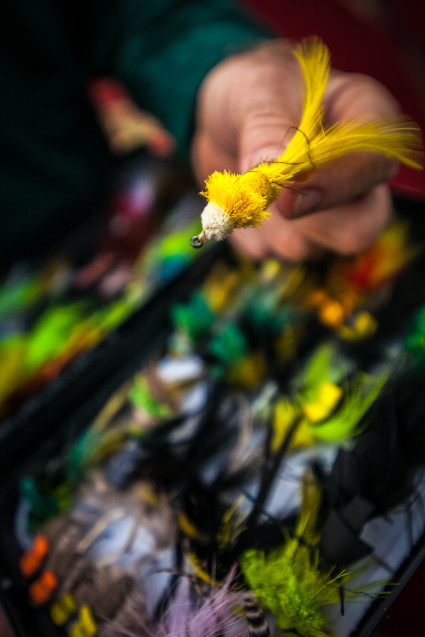 It takes a Fly rod with some horse power to get this done. I know people who use 4 or 5 weight rods to fish for Bass, but they’re going to be shut down at times because of the wind or the distances they need to cast. They also are going to be limited by the size of fly they can handle. Bass flies and bugs can be big. Not just heavy, but air resistant. It can be like trying to cast an umbrella. It takes a fly line that has enough mass to overcome the air resistance of a Bass Bug. The smallest rod I use is a six weight and I’ll be accepting some limitations when I do. An eight weight is a better all around choice. Rod length is another issue. A longer rod is easier to cast with and let’s you pick up line off the water easier. A shorter rod is more accurate and sometimes that’s important. Eight to nine feet will work well. By the way, if you have a good six weight and a good eight weight rod you’re pretty much covered for any freshwater fish in North America.
It takes a Fly rod with some horse power to get this done. I know people who use 4 or 5 weight rods to fish for Bass, but they’re going to be shut down at times because of the wind or the distances they need to cast. They also are going to be limited by the size of fly they can handle. Bass flies and bugs can be big. Not just heavy, but air resistant. It can be like trying to cast an umbrella. It takes a fly line that has enough mass to overcome the air resistance of a Bass Bug. The smallest rod I use is a six weight and I’ll be accepting some limitations when I do. An eight weight is a better all around choice. Rod length is another issue. A longer rod is easier to cast with and let’s you pick up line off the water easier. A shorter rod is more accurate and sometimes that’s important. Eight to nine feet will work well. By the way, if you have a good six weight and a good eight weight rod you’re pretty much covered for any freshwater fish in North America.
The trend with newer rods is to make them lighter and faster. Fast in this context means that most of the flex happens in the tip section. If you’re an expert caster that wants to squeeze out that last foot of distance, then this might be the rod you want. Most of us however would be a lot happier with a slower action rod. When you cast a fast action rod, your timing has to be very good. In other words, a fast action rod will reveal all of your casting faults. A slower action rod is much more forgiving and easier to fish with. You’ll often see the recommendation that you use a weight forward floating line that’s one or two sizes bigger than the rod is rated for. For example, a nine weight line on your eight weight rod. This is a sound idea and it works, but have you ever wondered why? It’s because that extra mass flexes the rod deeper and forces it to act like it has a slower action.
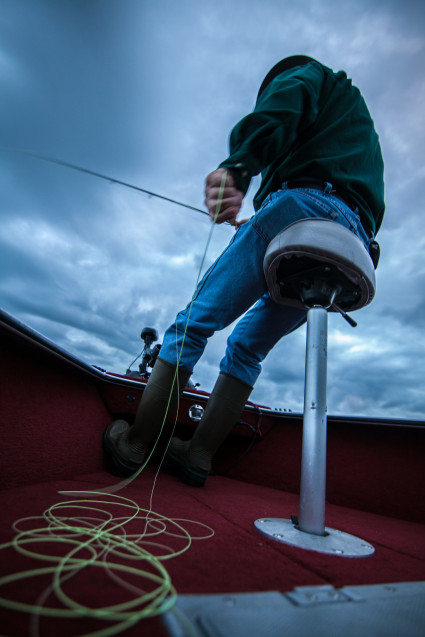 There are more good lines out there on the market than you can shake your fly rod at, and unless you pick something totally weird or cheap it’s hard to go wrong. To throw top water bugs, divers, and big streamers a weight forward floating line (WF8F, for example) works well and is fun to cast. Look for a line with an aggressive taper. A short heavy head followed by a thin running line will handle the big air resistant flies well. This line will cover everything from the surface down to four or five feet easily and will probably end up being your work horse line. The other line that will be useful is a sink tip. These come in different sink rates and that usually isn’t a big deal. You’re trying to get your fly down deep along the base of a weed line or along the bottom of a river in current so the heavier the tip the better. The casting stroke changes slightly with a sink tip. You can cast this line better if you open up your loop, usually by putting a little wrist into your casting stroke. Just a little, and minimize the number of false casts you make. Basically one or at most two back casts and then shoot it all out there. This keeps your fly in the water and it’s easier on your arms and shoulders.
There are more good lines out there on the market than you can shake your fly rod at, and unless you pick something totally weird or cheap it’s hard to go wrong. To throw top water bugs, divers, and big streamers a weight forward floating line (WF8F, for example) works well and is fun to cast. Look for a line with an aggressive taper. A short heavy head followed by a thin running line will handle the big air resistant flies well. This line will cover everything from the surface down to four or five feet easily and will probably end up being your work horse line. The other line that will be useful is a sink tip. These come in different sink rates and that usually isn’t a big deal. You’re trying to get your fly down deep along the base of a weed line or along the bottom of a river in current so the heavier the tip the better. The casting stroke changes slightly with a sink tip. You can cast this line better if you open up your loop, usually by putting a little wrist into your casting stroke. Just a little, and minimize the number of false casts you make. Basically one or at most two back casts and then shoot it all out there. This keeps your fly in the water and it’s easier on your arms and shoulders.
While I might not see the need for really expensive fly rods, I’d suggest you spend the money on a good fly line. Inexpensive fly lines are tough to throw, wear out early, and don’t work well when it get’s cold out. A decent line costs between $50 and $100. Keep it clean and store it somewhere cool and it will last for years. I can’t emphasize this enough: You can make almost any fly rod work, but you need a good line.
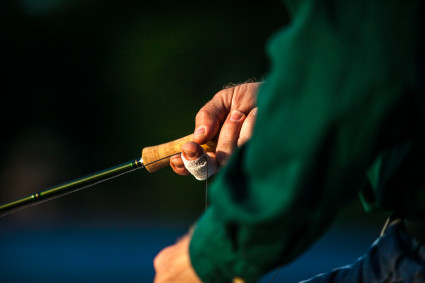 There’s been more written about leaders than rods and lines combined. It’s a huge deal with trout fishing. Bass, they really don’t care. Anglers using conventional tackle use really heavy line at times and they catch a lot of fish leading me to the conclusion that there’s not much need for fine tippets. Of course there will be exceptions to this. However the majority of Bass are going to be caught in and around some kind of cover. If they do grab your fly you have to lean on them to keep them out of trouble. The leader you use with your floating line should be about 9 feet long. Any longer than that and it gets difficult to turn over the fly and fly it all out in a straight line.
There’s been more written about leaders than rods and lines combined. It’s a huge deal with trout fishing. Bass, they really don’t care. Anglers using conventional tackle use really heavy line at times and they catch a lot of fish leading me to the conclusion that there’s not much need for fine tippets. Of course there will be exceptions to this. However the majority of Bass are going to be caught in and around some kind of cover. If they do grab your fly you have to lean on them to keep them out of trouble. The leader you use with your floating line should be about 9 feet long. Any longer than that and it gets difficult to turn over the fly and fly it all out in a straight line.
The easiest thing to do is buy a commercial available tapered leader that tapers to ten or twelve pound test. After you “use up” some of the tip and the leader starts getting short, tie on a piece of tippet and keep on fishing. One alternative to consider is a furled leader. You can make these on your own with a simple jig. You can experiment with tapers and lengths and make something that works well for you. I make a seven foot furled leader out of four pound test monofilament and loop two or three feet of ten pound test tippet and I’m in business. The advantage of a furled leader is that it will stay limp, it lays out nice and straight, and it will turn over a big fly. It also has a little bit of spring built into it which helps when a big fish becomes unruly on a short line. With a sink tip or full sinking line, it’s hard to beat a four or five foot section of Fluorocarbon leader material. It sinks, it’s less visible to the fish, and there’s no point in making it any longer. Because you’re fishing around cover a lot, it pays to frequently check the leader for abrasions and to re-tie knots fairly often.
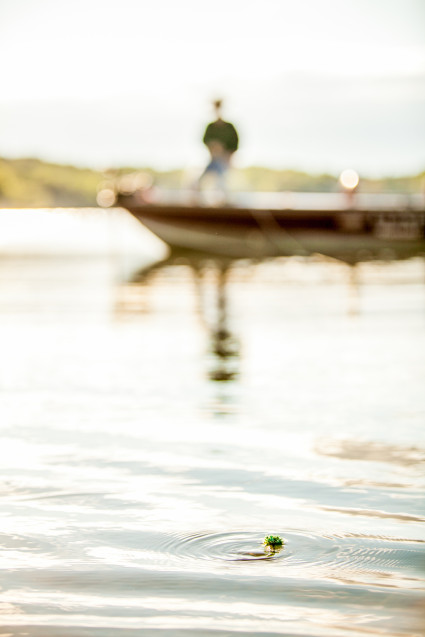 It’s pretty much impossible to cover the subject of flies and bugs in a few simple paragraphs. I think fly anglers like it this way and do it on purpose. There are millions of fly patterns out there and you will need about six of them. You need them in several colors and in at least two sizes. That’s gets us up to fifty or sixty flies right there. It adds up exponentially and you will never decide you have everything you’re ever going to need. We keep inventing and tying and using new materials and the pile just keep getting bigger. Let’s try and sort through this a little. You need Bass flies that float and you’re going to need some that sink.
It’s pretty much impossible to cover the subject of flies and bugs in a few simple paragraphs. I think fly anglers like it this way and do it on purpose. There are millions of fly patterns out there and you will need about six of them. You need them in several colors and in at least two sizes. That’s gets us up to fifty or sixty flies right there. It adds up exponentially and you will never decide you have everything you’re ever going to need. We keep inventing and tying and using new materials and the pile just keep getting bigger. Let’s try and sort through this a little. You need Bass flies that float and you’re going to need some that sink.
Of the floaters, you want some that stay on top (“Poppers”) and some that dive and float back up (“Divers”). Poppers can be made out of foam, hair, cork, plastic, or balsa wood. There are trade-offs and compromises between the various materials. The “hard bodied” bugs made of cork, plastic, or wood will float forever. They’re tough and have caught a lot of fish over the years. On the other hand, they float high enough in the water that a hard charging Bass might push it out of the way before he gets it into his mouth. Once he does grab it, he won’t like the hard texture and will spit it right away. You have to time the hook set just right. When a Bass crushes a foam or deer hair bug in his mouth it feels more like a real creature and they’ll actually try and swallow them. This gives you a little extra time to get that hook set. They’re lighter than their solid counterparts and are easier to cast. They don’t hold up as well and eventually the wear and tear of fishing will destroy them. Hair bugs will soak up some water and end up sitting lower in the surface film. They ”stick” better which means the Bass don’t blow them out of the water and miss them as often. The big downside with hair is that they will eventually waterlog and get hard to throw. If tying on a new, dry Bass Bug every 20 minutes really bothers you then you might want to stick with other materials. Personally I really like how hair bugs fish and tying on a new one isn’t a big deal.
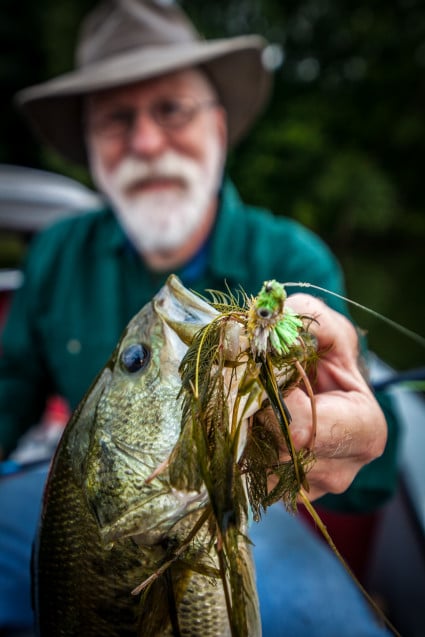 Foam is tough, cheap, floats, and doesn’t waterlog. Just make sure it’s closed-cell foam. Open cell foam soaks up water and will sink. I once made some beautiful looking Poppers out of foam ear plugs. They worked great for 3 minutes and then sank.
Foam is tough, cheap, floats, and doesn’t waterlog. Just make sure it’s closed-cell foam. Open cell foam soaks up water and will sink. I once made some beautiful looking Poppers out of foam ear plugs. They worked great for 3 minutes and then sank.
One last word on top water flies. The point of the hook has to hang well away from the body of the fly, or you will miss fish due to poor hooks sets. You almost want the hook to look oversized compared to the size of the body.
Sinking flies are either traditional Streamers or bottom bouncers. Streamers are designed to swim along and suggest either a leech or a bait fish. They can be tied with some weight to them, either heavy eyes or wire wrapped around the hook shank.
Favorites include patterns like Wooly Buggers, Clouser Minnows, Deceivers, Muddler Minnows, etc. You don’t have to worry about “matching the hatch” with a specific color and in fact the best producer for you might be fluorescent chartreuse or something equally strange. As always presentation is the most important thing to worry about, followed by size and finally color. Bottom bouncers are a more recent development and are an attempt to duplicate an effective technique used by anglers with conventional tackle, the jig. A big rubber-legged jig with a plastic trailer of some kind just might be the most effective single Bass bait ever invented and it makes sense to try and steal some of that magic. Effective patterns using heavy wire jig hooks, lead eyes, and Zonker strip (tanned rabbit) and rubber legs work just like a jig and catch a lot of Bass. The best ones have most of the floating materials tie on the upper side of the fly and the heavy eyes on the bottom to make the hook ride up, reducing hangups. Pretty much any water that holds bass has a population of Crayfish. Bass will target them heavily when they are in season, making this presentation very effective.
You will need a big fly box to hold Bass sized flies in. My “boat box” is an inexpensive plastic handgun case. I cut slits into pieces of quarter inch thick foam and glued them inside the box. For ten dollars I have a box that will hold dozens of big flies. Other accessories that are useful include knot tying tools, nippers, and spare tippet.
Becoming a competent caster is central to all fly fishing. Warm water Bass fishing closely resembles salt water fly fishing. The wind, big flies, and longer distances are very different than conditions encountered in Trout fishing. You have to become a competent caster to successfully fish for Bass. This means getting some instruction, either through classes or purchasing a video and then practicing. Fifteens minute a day and you will become very good. Your objective is tight, high speed loops. Throw your back casts high and drive your forward casts low, and aim for an imaginary spot a foot above the water. This will help your accuracy and let you drop your fly onto the target with a minimum amount of commotion. This is a big part of the fun. Working your way down a shoreline rife with targets and dropping your fly into nooks and crannies is enjoyable even if the fish aren’t biting well. Learn how to double haul and it becomes easy to make 50, 60, or 70 foot casts all day long. Once you learn how to double-haul these kinds of distances are feasible, but maybe aren’t recommended. Distance is the most over-rated thing in fly fishing. In any kind of fishing it is harder to hit your target, set the hook, manipulate your lure, and fight a fish on the end of a long line. It’s much better to sneak into position and make a shorter cast. Practice long and fish short! If you can make an 80 foot cast, then you can fish 50-60 feet away all day long without fatigue.
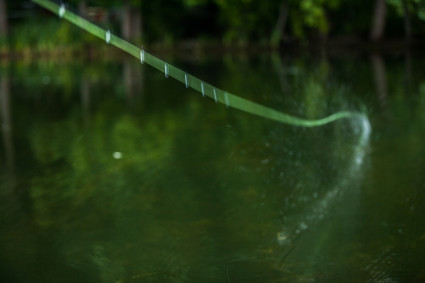 Making a good hook set involves a quick strip of the line while pulling the rod back. When you’re fishing everything should be in a straight line. The rod, the line laying on the water, and the leader should all lie in a straight line. The rod tip should be right down near the surface of the water. When you get a hit, make a sharp pull with your stripping hand and try to keep the rod tip down. Fly rods are made to bend. Raising the rod tip will bend the rod but won’t put much pressure out at the hook point. At the same time you’re stripping line, move the rod back. This is easy to explain and hard to do, especially if you’ve done a lot of fishing with conventional gear and are used to hauling back on the rod. It’s well worth mastering this technique.
Making a good hook set involves a quick strip of the line while pulling the rod back. When you’re fishing everything should be in a straight line. The rod, the line laying on the water, and the leader should all lie in a straight line. The rod tip should be right down near the surface of the water. When you get a hit, make a sharp pull with your stripping hand and try to keep the rod tip down. Fly rods are made to bend. Raising the rod tip will bend the rod but won’t put much pressure out at the hook point. At the same time you’re stripping line, move the rod back. This is easy to explain and hard to do, especially if you’ve done a lot of fishing with conventional gear and are used to hauling back on the rod. It’s well worth mastering this technique.
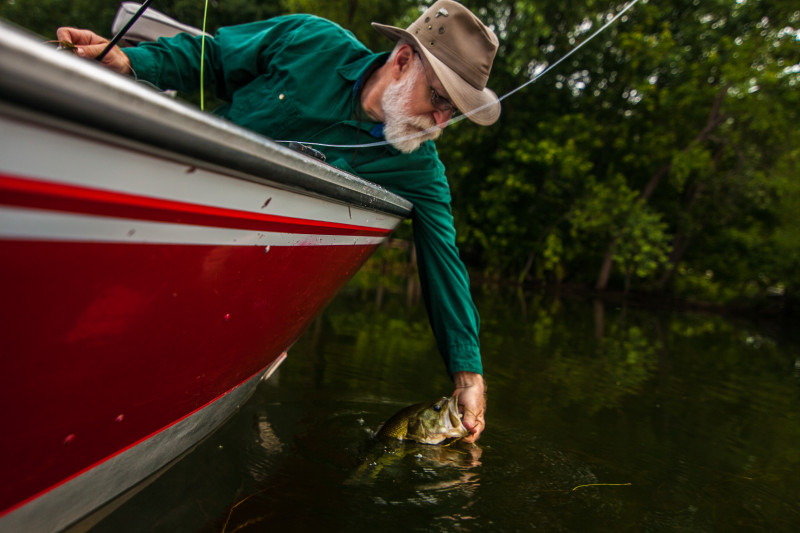
It would take an entire book to cover all aspects of Bass behavior, habitats, and tactics to catch them. We can narrow this subject down by concentrating on the top 15 feet of water where Fly fishing is most practical. Predators like Bass tend to favor edges. This includes weed lines, transitions from one type of weed to another, rocks, docks, and depth changes. Most of that happens in the top 15 feet of water. Top water bugs can be a very effective way to catch fish in these areas. Flies would include Deer Hair bugs, Poppers, Divers, and foam creations. First, they have the advantage floating over the weeds and other snags so you won’t get hung up as often. Secondly the noise they make will get the attention of any Bass in the area. Even if they don’t want to eat it, they’re going to know it’s there. Lastly a floating line and tapered leader will let you drop a fly on target with very little commotion. If the Bass are spooky or pressured this can be a huge advantage. There aren’t any hard and fast rules regarding presentation. Once the bug is on target, you will have to experiment to see what will trigger the bass to hit it. On some days they will respond to a quick, aggressive retrieve. On other days you might shake it without moving and then let it sit for up to minute or even more before they hit it. Pay attention to what is working and then keep doing that. Don’t set the hook when you see the strike, or you’ll just take it away. Let the Bass turn with the bug and then lower the boom. Your hooking percentage will be a lot higher.
Think about cover and ambush points. The bass are going to position themselves where they can ambush their prey. For example, when you’re fishing docks think about the position of the sun and where the shadows are. Look for any weeds or deeper water close to the dock. And finally look for a ladder. Bass will frequently hide next to the ladder and peer out from under the dock. Drop you fly in there and give them a chance to eat it. And then hang on!
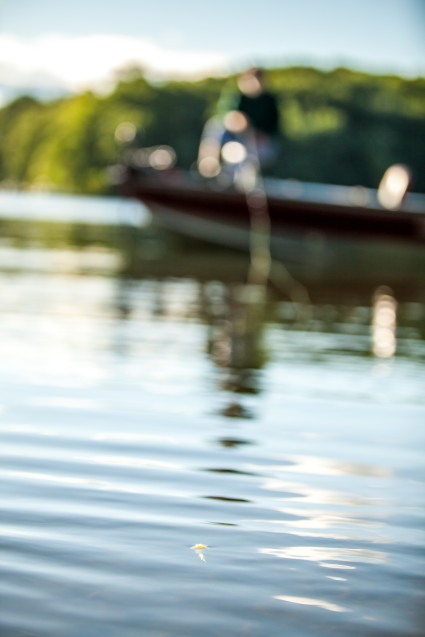 Sub-surface Bass fishing involves the same principles. Here you’re going to be using streamers like the Clouser Minnow, Deceivers, or Zonker strip flies tied on jig hooks. Look for edges, holes in weedbeds, overhead cover like logs or floating weed mats. Most of the time you won’t see the fish hit so you’re feeling and watching. The bigger the Bass, the softer the hit will be. They come up behind your fly and snap their mouth open and suck the fly in. It can be a very subtle thing. You can frequently see the fly line twitch or move and use that as an indication to set the hook. Basically, if anything unusual happens set the hook. You will be amazed at how often it’s a fish. Depending on the depth you might be required to use a sink tip line, weighted flies, or a combination of both. Let’s imagine you’re fishing a weedline. Cast as parallel to it as possible, and then count your fly down. That sounds easy, however the first few casts you make are either not going to get deep enough or you’re dredging in weeds until you find the magic number. Cast, count down to get your fly near the bottom, and begin your retrieve.
Sub-surface Bass fishing involves the same principles. Here you’re going to be using streamers like the Clouser Minnow, Deceivers, or Zonker strip flies tied on jig hooks. Look for edges, holes in weedbeds, overhead cover like logs or floating weed mats. Most of the time you won’t see the fish hit so you’re feeling and watching. The bigger the Bass, the softer the hit will be. They come up behind your fly and snap their mouth open and suck the fly in. It can be a very subtle thing. You can frequently see the fly line twitch or move and use that as an indication to set the hook. Basically, if anything unusual happens set the hook. You will be amazed at how often it’s a fish. Depending on the depth you might be required to use a sink tip line, weighted flies, or a combination of both. Let’s imagine you’re fishing a weedline. Cast as parallel to it as possible, and then count your fly down. That sounds easy, however the first few casts you make are either not going to get deep enough or you’re dredging in weeds until you find the magic number. Cast, count down to get your fly near the bottom, and begin your retrieve.
Again it will take some experimentation to find out what the bass might react best to on a given day. You can even hold the rod under your upper arm and retrieve “hand over hand”, allowing you to strip the fly back fast and steady. More typically a halting retrieve with jerks and pauses will work better. You’re the puppeteer and the fly is the puppet. Make it act alive. Don’t be surprised by the occasional Northern Pike, Walleye, Crappie, or Dogfish when you’re fishing this way. Every fish in the lake uses an outside weed line at some point and if you put a baitfish or leech imitation down there it will get eaten sooner or later.
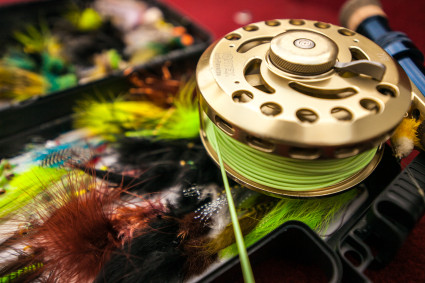 There are some variations with presentation that can be deadly under the right circumstances. And these methods are almost impossible to duplicate with conventional gear. Imagine you’re staring at a broad expanse of surface weeds that has an occasional hole in it. The edges of that hole are edges, and will be used by Bass as an ambush point. Imagine you have a sink tip line, a short heavy leader, and a floating diver type top water fly. A Dahlberg Diver would be an excellent choice. Throw over the leaving the Bug sitting on the weeds and the sinking fly line drooping down into the hole. Now when you make a sharp strip, the bug will hop off the weeds and dive towards the bottom. When you pause it will hesitate and then slowly start to float back to the surface. This looks a lot like something edible that’s trying to get away, isn’t completely healthy, and is vulnerable. The Bass will climb all over this one.
There are some variations with presentation that can be deadly under the right circumstances. And these methods are almost impossible to duplicate with conventional gear. Imagine you’re staring at a broad expanse of surface weeds that has an occasional hole in it. The edges of that hole are edges, and will be used by Bass as an ambush point. Imagine you have a sink tip line, a short heavy leader, and a floating diver type top water fly. A Dahlberg Diver would be an excellent choice. Throw over the leaving the Bug sitting on the weeds and the sinking fly line drooping down into the hole. Now when you make a sharp strip, the bug will hop off the weeds and dive towards the bottom. When you pause it will hesitate and then slowly start to float back to the surface. This looks a lot like something edible that’s trying to get away, isn’t completely healthy, and is vulnerable. The Bass will climb all over this one.
Another way to use this same setup is around rocks and sunken wood. Let the sink tip or sinking part of the line reach the bottom. The floating bug will stay above the bottom, avoiding snags and hanging there visible to any predators in the area. When you strip the fly will head towards the bottom as though it’s attempting to hide or flee. Then it slowly floats back up. Smallmouth Bass in colder water have a hard time ignoring this presentation. A third example would be over a bed of scattered cabbage or coontail. The Bass will be under the canopy or even on the bottom under the overhead cover provided by the weeds. A top water fly might be ignored, but not if you bang into the weeds with it. Using a floating line and a floating diver type fly, cast out over the weedbed and strip the fly down so it makes contact with the weeds. Then hesitate and allow it to slowly float back towards the surface. I have had days when this was the only presentation that was putting fish in the boat, period.
I hope this inspires you to try Bass fishing a fly rod. It just might lead to a lifetime of fun and satisfaction.
About the author-
Steve “Rootski” Root lives to fish with the long rod and can be found on summer mornings chasing largemouth bass predawn on lakes near Minneapolis / St. Paul, MN. You can reach Steve online at In-Depth Outdoors by sending him a private message.
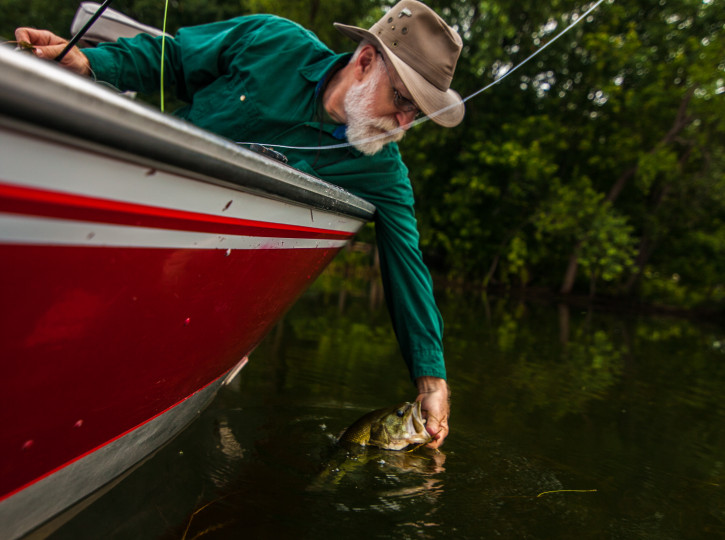
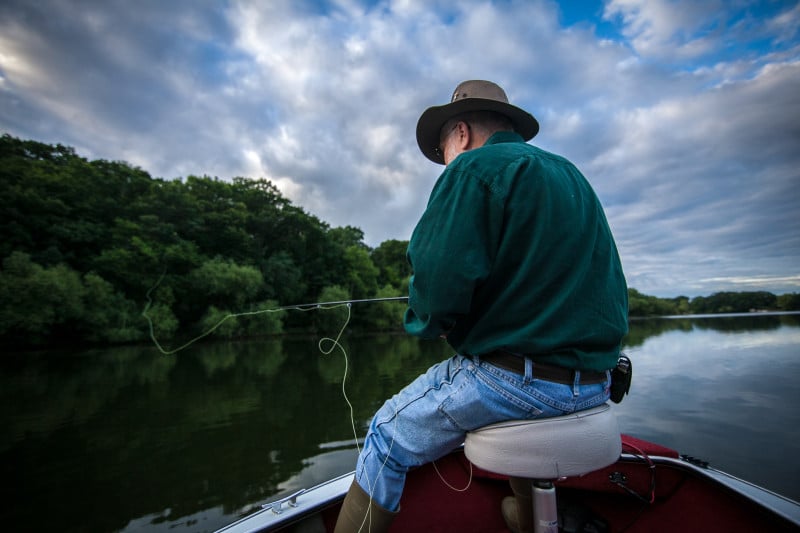
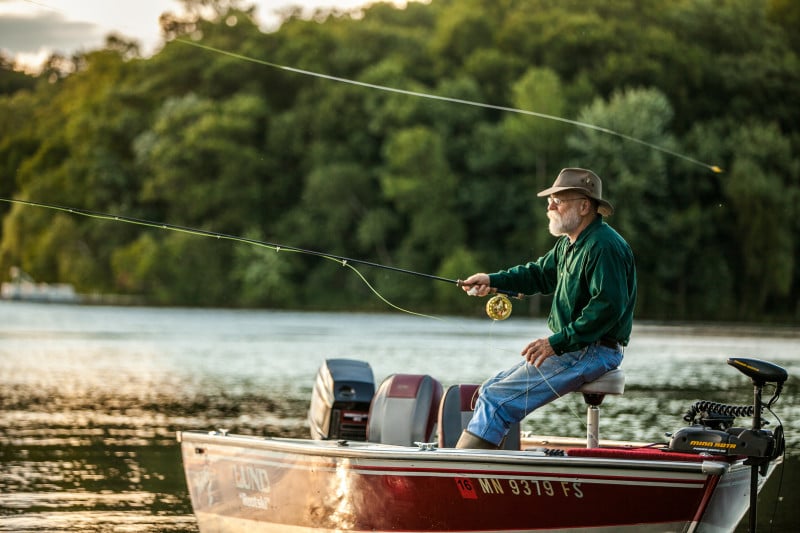
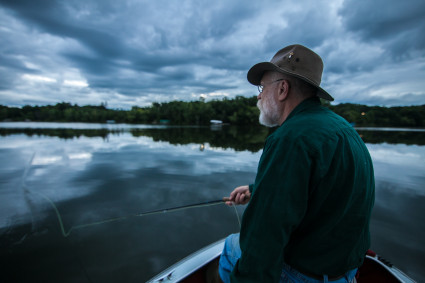
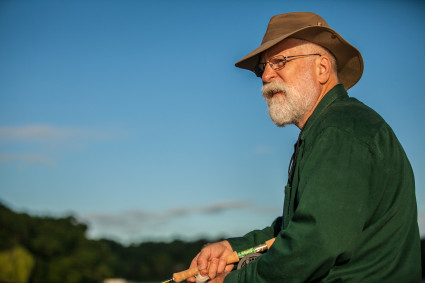
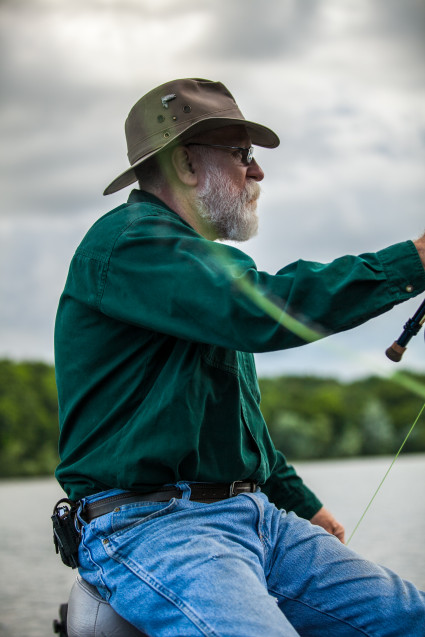
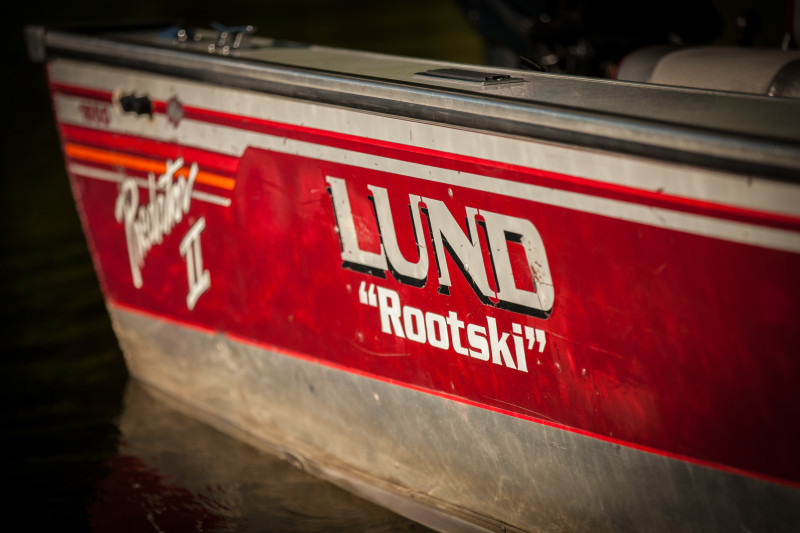
Very good Rootski! In-Depth Outdoors very own in house fly fishing guru!
After reading that, it’s time to put down the bullheads and the big rods and pull out the ol’ fly rod.
We need to get out there!
Let’s do it BK. Are you seeing any White Bass activity down your way? We’ve been talking about dong that for a long time now.
Who took the great pictures? I got ADD, so I haven’t read the article yet.
That would be Ben Brettingen. He’s handy with the still camera.
Where did you find that great hat? A good looking fedora always makes a man look more distinguished.
Yes Root, you need that forward cast photo framed. No doubt!
Great article Dad! Lots of great info and of course it’s always fun reading your work. And great pictures, Ben!
Brent does do a fantastic job with his pictures. I like his style. Its far better than just the “normal” shots without “post effects” on other sites and in magazines. It really does add a lot of value to the articles.
Great Job Steve!!
Always enjoy reading your posts.
Lets get out soon, I know some smallies that you need to meet.
Ron
Sounds good to me! It’s been too long.
Nice work Rootski!
-J.
IDO is on to some amazing stuff here, these articles coupled with the reports are the best in the business right now.
Really inspired me to get my old fly rod out as well Rootski, and those tips are going to be the difference in catching some fish. Thanks and a great read man!